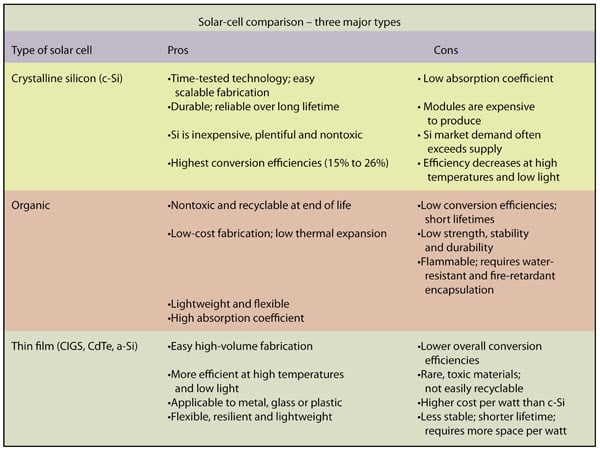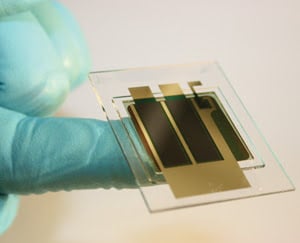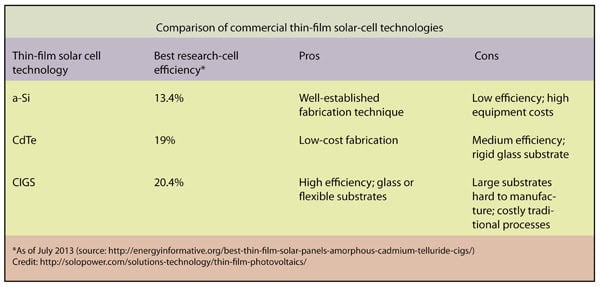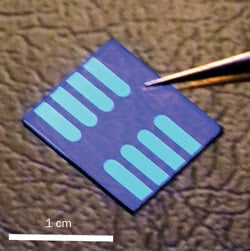
Better Materials Mean Better Solar Cells
Innovation in materials research is revealing a future in which solar power is inexpensive and efficient, and sunlight-harvesting thin films cover everything from airplanes to buildings.
Crystalline silicon, or c-Si, is the dominant photon-absorbing material in conventional solar cell technology; it made up nearly 90 percent of the modules produced globally in 2012. Although no other material comes close to replacing plentiful, inexpensive c-Si – thin film is a distant second – the technology still isn’t cheap enough in most global markets to justify replacement of conventional electricity sources (unless government incentives and feed-in tariffs are applied). As an energy source, c-Si may be greener and safer than coal or nuclear power, but until solar reaches widespread grid parity – the point at which the levelized cost of the electricity it generates is equivalent to that of the existing conventional electricity grid – researchers must continue to improve existing technology.
Conventional c-Si solar cells are a time-tested technology with some of the highest commercial conversion efficiencies. Many commercial modules offer efficiencies in the range of 15 percent, while cutting-edge designs using solar concentrators are reaching 26 percent, according to the National Renewable Energy Laboratory.1 The material’s popularity is partly due to this high efficiency and partly because cells are directly fabricated on bulk Si wafers using well-established semiconductor fabrication techniques. Also, c-Si installations are reliable over a long lifetime – 25 years or more – and the modules are fairly rugged (see Table 1).

However, besides the troubling cost to fabricate c-Si modules, silicon generally has a low absorption coefficient, and conversion efficiency decreases at high temperatures. As a module heats up on a sunny day, it produces electricity less efficiently. Efficiency also is low in diffuse light conditions; e.g., on a cloudy day. So researchers are keen to find better alternative materials.
Other types of solar cells attempt to remedy these shortcomings, the classification of which can be tricky. Bernard Kippelen, a professor of engineering at Georgia Institute of Technology in Atlanta, said that, as a rule of thumb, photovoltaic (PV) materials can be classified in three main categories: c-Si, thin film and organic. But the categories overlap, and various communities use various definitions. For example, organic and thin-film PVs often overlap as organic thin films, but sometimes thin films have inorganic or hybrid organic-inorganic layers. The III-V category of molecular beam epitaxy-grown and metallorganic chemical vapor phase epitaxy-grown semiconductor multijunction solar cells are thin films that are more efficient than c-Si (they currently hold the world record), but their commercial use is limited because they are complex and expensive to fabricate.

New materials are first tested on small cells, then on larger solar films produced in the lab. If successful, the material is released for commercial production. Photo courtesy of Heliatek GmbH/T. Baerwald, Berlin.
Furthermore, solar cells often are classified as first, second and third generation. First-generation cells are the dominant technology in the vast majority of commercially produced cells on the market (typically c-Si with various p-n junction designs). The second generation is less efficient but cheap enough to offer lower cost per watt; e.g., thin films such as cadmium telluride (CdTe) heterojunction cells. The third generation includes numerous alternatives that promise higher efficiencies and lower cost per watt, but face challenges such as fabrication, efficiency and/or cost (e.g., dye-sensitized, organic and quantum-dot solar cells).

In January 2013, Heliatek announced a world-record organic thin-film
solar-cell conversion efficiency of 12 percent on an active area of 1.1
cm2. Photo courtesy of Heliatek GmbH.
“However,” Kippelen said, “these definitions are somewhat misleading, too, because they convey a progression in time that does not always reflect reality.”
The thin-film solar market is currently dominated by CdTe technology, particularly that of First Solar in Tempe, Ariz. Thin-film PV is more flexible than c-Si and has an average thickness of a few microns, compared with that of c-Si, which is about 150 to 200 µm. Thin-film sheets, usually about 1 m2 in size, are produced using common printing or vapor-deposition processes, which lend themselves to inexpensive, high-volume manufacturing.
Sheets of thin-film solar cells can be applied to flat or contoured surfaces such as metal, glass or plastic. To compete
with c-Si’s cost per watt and efficiencies, thin films typically have a large foot-print. Their large module size requires more real estate, so First Solar’s CdTe thin-film technology is primarily used in large-scale utility applications where land is plentiful, such as solar farms in arid regions. Other types of thin films include copper indium gallium diselenide (CIGS) and amorphous silicon (a-Si) (see Table 2).

High-efficiency organic
Progress has recently heated up in organic materials R&D for PV applications, thanks to their compatibility with high-throughput, low-cost solution-phase processing. Organic photovoltaics (OPVs) typically do not have high conversion efficiencies, but what they lack in raw power, they make up for in low fabrication cost and in their ability to be applied as thin films to various surfaces. Organic-based solar cells aren’t as strong and durable as c-Si, so lifetimes are typically short, but the materials’ eco-friendliness means easier disposal at end of life. More conventional solar cells, especially those based on cadmium and other toxic materials, are difficult to dispose of properly.
In January, organic solar film company Heliatek GmbH of Dresden, Germany, in cooperation with the University of Ulm and TU Dresden, announced a world-record conversion efficiency of 12 percent for its organic solar cells. The record-setting cell combines multiple layers of two patented small-molecule oligomer absorber materials that convert light of different wavelengths on a standard cell size of 1.1 cm2. The efficient absorption of OPV at high temperatures and low-light conditions means that 12 percent efficiency is comparable to the 14 to 15 percent efficiency of conventional c-Si.

Heliatek’s ultrathin organic solar films will be produced with different transparency levels, enabling building glass to harvest energy. Photo courtesy of Heliatek GmbH/Corbis.
The vacuum deposition of oligomers, which has been used successfully on OLED displays for a decade, layers numerous ultrathin (5-nm thick) coatings, one on top of the other, to create tandem- and triple-junction cells that absorb a broader spectrum of light. Commercial products integrated with Heliatek’s energy-harvesting OPV film are expected to hit the market later this year.
Another way for organic PV to compete with c-Si is to make the technology so cheap that efficiencies don’t have to be record-setting. A team of scientists at the University of Southern California, Los Angeles, recently reported building a new type of organic thin-film solar cell with active light-absorbing layers comprising a bulk heterojunction mixture of organic polymers and cadmium selenide (CdSe) nanostructures. The two components provide complementary absorption in which the polymer absorbs into the near-IR, which boosts efficiency.2

Proof-of-concept thin-film organic solar cells comprising polymer/CdSe nanostructures, recently built at the University of Southern California, Los Angeles, may lead to ultralow-cost, high-efficiency solar cells. Photo courtesy of R. Brutchey/University of Southern California.
Their study of the third-generation solar cell is the first to show that CdSe nanostructures can be used as a general electron acceptor with various polymers to create efficient solar cells, said Richard Brutchey, USC associate professor of chemistry. Their proof-of-concept hybrid cells reached 3 to 4 percent efficiency, an improvement over previous examples of polymer/CdSe devices, and “a very high efficiency for this type of hybrid solar cell,” Brutchey said. The team calculates that this can easily be increased to 10 or 12 percent, making it useful in niche applications such as ultralow-cost flexible conforming solar panels on textiles and other nonrigid surfaces, and on solar-harvesting tinted windows.
Greener solar
Solar energy is free and sustainable, and lessens our dependence on fossil fuels, but Kippelen said neither glass nor plastic-based solar cells are easily recyclable. “If they end up in a landfill, we’re swapping one problem for another. To make solar cells even greener, we want to replace the substrate with cellulose or other materials that are natural, nontoxic and sustainable.”

To make solar energy even greener, a recyclable substrate for solar cells incorporates a film made from carbon nanocrystal fibers, the smallest constituents of wood. The solar cells can be easily dissolved in water into their major components for end-of-life recycling. Photo courtesy of Virginie Drujon-Kippelen.
He and colleagues have designed a green, renewable and recyclable substrate using cellulose nanocrystals (CNCs), the smallest constituents of wood. The CNC substrate is a film so thin (100 µm thick, supporting a 100- to 200-nm-thick active absorbing layer) that it is optically transparent – and it is water soluble. At the end of its lifetime, the solar cells can be quickly separated from the substrate by immersion in water. Recently, the group announced that organic cells fabricated on the substrates reached a conversion efficiency of 4 percent, an unprecedented figure for such cells.3
“We should easily get to five percent in a few months,” Kippelen said, “and before long, we’ll improve it to ten percent. If we reach even five percent efficiency in a solar cell that lasts five years, the low cost will make the technology viable for several niche applications, such as wireless sensors and environmental and agricultural sensing.”
The team also is working on an encapsulation barrier consisting of a coating of an aluminum-oxide compound using atomic layer deposition.

Tinted transparent organic solar films can be integrated between two glass sheets to provide windows with shade and energy simultaneously. Organic photovoltaics do not generally have high conversion efficiencies, but they boast low fabrication costs and can be used as thin films on various surfaces. Photo courtesy of Smack Communications, Berlin.
Nanowires
PV startup Sol Voltaics of Lund, Sweden, is working on another angle of solar materials: thin layers of nanowires applied to the top of a solar panel. The company is making an active ink of gallium arsenide (GaAs) nanowires that create
an additional absorptive layer on top of solar cells to raise conversion efficiency from 17 to 22 percent (a 25 percent improvement). C-Si solar manufacturers will pour the nanowire ink solution, which contains tiny solar cells measuring 2 µm x 100 nm, over approximately 12 percent of an existing cell, fix it in place with a polymer and laminate it
with a transparent conductive oxide.
The company projects that the increase in efficiency will improve cost to an average of 94 cents per watt for higher-efficiency panels and to 42 cents per watt for low-end modules. Although PV manufacturers (typically in Asia) will have to install three new tools to their production lines, the nanowire material will be cost-competitive with silicon. The company currently is raising funds, aiming for a pilot commercial product in 2015 and full production in 2016.
References
1. http://www.nrel.gov/ncpv/images/efficiency_chart.jpg
2. M. Greaney et al (July 2013). Novel semi-random and alternating copolymer hybrid solar cells utilizing CdSe multipods as versatile acceptors. Chem Comm, 10.1039, advance article (doi: 10.1039/C3CC44536D).
3. Y. Zhou et al (March 2013). Recyclable organic solar cells on cellulose nanocrystal substrates. Sci Rep 3, No. 1536 (doi: 10.1038/srep01536).
Published: September 2013